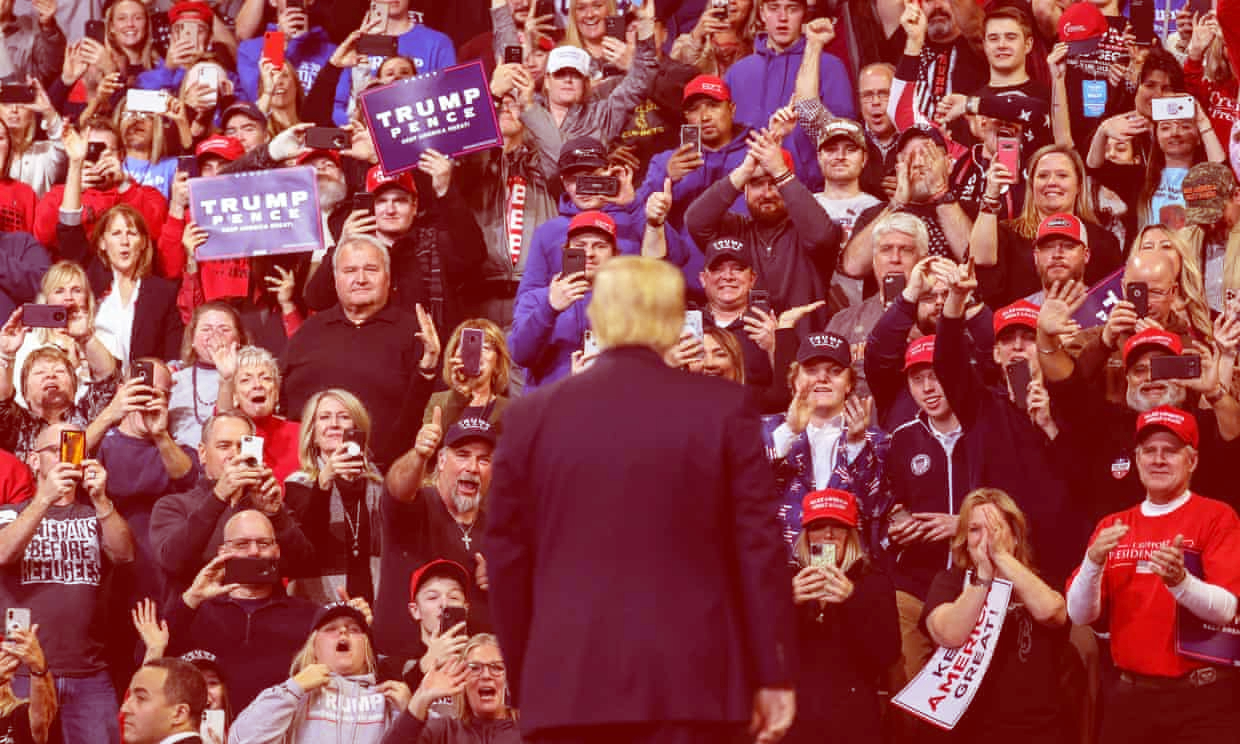DONALD Trump’s first term has come to an end. In the wake of the year of COVID-19, heroic mass protest movements over the summer and a genuinely vicious (and frequently deadly) backlash from the nativist and reactionary right, it’s worth taking a moment to reflect on the significance of Trump from a cultural point of view. It’s almost necessary to take that position, as both Trump and the broader Trumpist right have intensified the erosion between the culture/politics distinction. Trump isn’t a politician and never has been. He’s a TV guy, who just happened to get a gig hosting the biggest media spectacle while the American Empire slouched further into decline. If, after the twentieth century, the allegedly autonomous space of culture has collapsed, then with a celebrity presidency all culture has necessarily become political.
Trump and and the phenomenon of Trumpism are instructive because they express to an extreme degree a broader shift in the relationship between culture and politics. As I’ve written elsewhere, the Trumpist line on culture is driven by a contradiction: cultural texts should be free of politics, but are also and at the same time a site in which political desires and drives can be channelled and manipulated. Trump understood this, however inchoately, from the beginnings of his initial run for the presidency, forming a highly-effective feedback loop between his campaign and the media, and generating countless hours of free ad time, exposure and attention.
The Trump phenomenon may have been treated as a disaster by the liberal media, yet the constant hum of outrage that surrounded Trump both failed to actually damage his political career and revealed the media to be ineffectual at best and complicit at worst ‒ a point liberal media figures now (finally) admit to be true. The consequence of having the guy on TV wield America’s political machinery is a cultural movement based on consumption, passivity and resentment ‒ a fitting culmination of trends that have been stoked in American political discourse which go at least as far back as Ronald Reagan.
“The Trumpist line on culture is driven by a contradiction: cultural texts should be free of politics but are also and at the same time a site in which political desires and drives can be channelled and manipulated.”
To place this in context it’s worth (re)turning to one of the most important theorists of contemporary cultural politics, Guy Debord, and his book The Society of the Spectacle, an aphoristic manifesto for the Situationist International. Perhaps the text of the 1968 protest movement, it was a diagnosis of a widespread cultural condition in which people experienced and related to the socio-economic totality as a “spectacle.” Beyond an amalgamation of images, representations and appearances that constitute a determining force in culture and politics, the spectacle structures the ways in which people relate to one another.
As Debord put it, “the Spectacle is not a collection of images, but a social relation among people, mediated by images.” While the technologies of the spectacle have obviously grown more sophisticated since Debord’s text, the methodological techniques remain very similar. Debord insisted that communicative technologies develop in step with the preexisting needs and structures of the spectacle itself. So, when Debord writes that the spectacle is “the ruling order’s nonstop discourse about itself, its never-ending monologue of self-praise, its self-portrait at the stage of totalitarian domination of all aspects of life” we can see a remarkably prescient diagnosis of the current cultural politics of America.
This happens constantly in performative mainstream journalism and media, with its constant self-hagiography. But is also rampant in online spaces, the wellspring of Trumpist talking points and conspiracies. Trump’s fondness (and, let’s be honest, skill) for social media allowed for the intensification of attention to permeate the social media ecology ‒ one that couldn’t be corrected by the mainstream. An ouroboros of discourse, constantly feeding off attention and affective investment, Twitter sells itself as a conversation platform but it was easily engineered into a gamified attention economy (quite arguably what it was from the very beginning). In the hands of a grifting entertainment figure like Trump, it becomes self-sustaining. No longer do you have to rely on generating and maintaining the mechanisms of the spectacle when supporters and fans will not only willingly subordinate themselves to the spectacle machine but will help build it for free.
This intense, affective investment in an idealized image has been a pronounced feature of Trumpist cultural politics. Phoenix Andrews has written extensively about how politics increasingly functions as fandom, with spectators invested in their “faves” and unswervingly dedicated to upholding the idealised image of the individual. What’s striking is the way that the Trumpist coalition understands that image to be both fixed and flexible. There’s the reactionary populist section, which, driven by xenophobia and nationalism, sees Trump as a bulwark against the foreign other (this image being perhaps the funniest one in the sheer scale of the gap between the image and reality). There is also the paleoconservative nostalgia for a mythic, prelapsarian time of isolationism and protectionism, redolent in the slogan “Make America Great Again.” There’s the libertarian pipedream of a possible future where we all get to make real estate deals and pay no taxes or the evangelical fantasy of the American theocracy they’ve lusted after for generations. All of these images can be held together simultaneously, like a brand diversifying its portfolio to appeal to the widest possible demographic. They all serve a particular purpose, too: historically, the political right saw culture as a means to unify a disparate populace behind shared values, whereas for Trump culture unites an assumed homogeneous bloc behind his own drives and desires.
However, if Trumpian politics is now a kind of total culture, it’s delivered and mediated by technologies that, as Debord put it, “create lonely crowds.” For Debord, the society of the spectacle is an expression of widespread alienation, itself a product of capitalism. The Trumpist right’s investment in the spectacle machine won’t solve the problem of capitalist alienation, it’s merely disguising the true problem. As Debord puts it towards the end of chapter one of Society of the Spectacle: “Spectators are linked solely by their one-way relationship to the very center that keeps them isolated from each other. The spectacle thus reunites the separated, but it reunites them only in their separateness.”
Politics is passive, something you watch on live streams, or Twitter, or Gab. You might get to join in, but only as one profile picture among a sea of others. This is why Debord introduces a useful distinction between “concrete” and “diffuse” spectacles. Whereas the concrete spectacle is specific to totalitarian and Stalinist regimes, the diffuse spectacle proliferates in wealthy and apparently “free” societies, where it feeds off of the perpetual sense of lack masked as consumer choice. You may get to feel like part of a movement, but only in terms that reinforce your essential atomization as a good, neoliberal consuming subject, bereft of true movement power.
“Historically, the political right saw culture as a means to unify a disparate populace behind shared values, whereas for Trump culture unites an assumed homogeneous bloc behind his own drives and desires.”
It’s worth contrasting this with the narrative drawn out of Vivian Gornick’s remarkable book The Romance of American Communism, an oral history of people involved in the US communist movement in the early twentieth century. One of the most striking themes throughout the stories that Gornick collects is the degree to which the Communist party was not simply solving a political problem for its participants, but an existential one.
“paradoxically, the more each one identified himself or herself with the working-class movement, the more each one came individually alive. The more each one acknowledged his or her condition as one of binding connectedness, the more each one pushed back the darkness and experienced the life within.” (p. 8)
In contrast to the right-wing caricature of the Communist as the subject who loses themselves in the masses, Gornick shows that, for communists, it is through the mass work of the party that people actually discovered their individuality and their interdependence in a new way. To be a communist was not to lose one’s humanity but find a way of experiencing and expressing it to the fullest. In contrast, while Trumpist cultural politics has the appearance of this kind of connection, the rallies, protests and online talking heads serve only to underscore the extent to which all of it is a branding exercise ‒ a series of images designed to sell commodities, from red baseball caps, to ebooks, to the libidinal thrill of owning the libs.
The “diffuse” spectacle of Trumpism is not just about consumption, though. More fundamentally, it secures passivity. After all, spectators are by their very nature not actors. There can be no genuine mass political agency as this would threaten the mode of production and organization of economic forces that the spectacle exists to maintain and perpetuate. This passivity is something that runs rife through Trumpian culture. Think of the constant conspiracism or the near-omnipresent belief that their enemies are simultaneously weak and pathetic while also being terrifying villains out to destroy the country and murder opponents. These fixations have the contradictory yet ideologically necessary function of both galvanizing and pacifying, allowing supporters to feel as if they are involved in some titanic struggle while obscuring their true political impotence.
The Capitol riot earlier this month, trumpeted by many as a display of fully-fledged far-right power, also falls into this category. Rioters broke into a building, keeping well within the velvet ropes, and eventually made their way into the offices of some of the most powerful people in the world. Yet, when they got there, they mostly milled around, stole a few symbolic objects, and took pictures of one another pretending to be these powerful people, sitting in their chairs with their feet on their desks. The majority of the crowd seemed to just . . . be around the place. Unsure what to do. In the language of video games, they had completed the Capitol level but nothing had happened. They left and went home, back to their successful businesses, to talk about what they had done online and then be arrested by the federal government.
This flash of political theater testifies, again, to the essential inability of this movement to reckon with alienation. The protestors went to the Capitol building not in spite of the cameras there, but because of them. If the substance of their cultural politics is, as Debord writes, an “immense accumulation of spectacles” that structures even their social relations, then arguably the protestors fondness for selfies and live streams can be understood not just as incompetence but as a reflection of a desire to see themselves in the stream of images that mediate and determine the spectacle of Trumpism.
Finally, resentment. Unable to confront the true problems of capitalist alienation and libidinally invested in the consumption-based politics of the spectacle, resentment is almost guaranteed. From a certain point of view this kind of affective investment is both politically and financially expedient for Trump and his acolytes. Tapping into spectators’ libidinal desires and emotions can be an effective means to ensure financial income and the necessary distributive networks to keep generating revenue. In this, the Trumpist right has learned from the Christian evangelical movement, which has perfected a cultural politics of resentment over decades, essentially creating its own cultural ecosystem of films, books, movies and media that serve to whip up a base into a spectacular political and cultural fervor.
But, once again, all of this simply serves to disguise the true antagonisms and problems of a particular societal structure. Or, to quote Debord once more, the “image of blissful social unification through consumption merely postpones the consumer’s awareness of the actual divisions until his next disillusionment with some particular commodity.”
“The ‘image of blissful social unification through consumption merely postpones the consumer’s awareness of the actual divisions until his next disillusionment with some particular commodity.’ (Debord)
We should note that the spectacularization of politics is not something confined to the right. The Trumpist crowds have just provided the most high profile example of it. If there is anything to learn from the cultural politics of Trump, it’s that the politics of the spectacle are a frenzied stasis, a “unity in disjunction” that will endure even with the election of Joe Biden. The celebratory discourse that politics will get “back to normal” is both a promise and threat. What’s more promising is a movement that could overcome the alienation that the spectacle can only conceal ‒ a possibility only the left can realize. The best tool here is still, as Debord pointed out, Marx’s theory. Marx sought to ‘understand struggles, not laws,’ to look beyond the naturalised state of things to uncover the true material history of class struggle.
There’s a crucial warning in Debord’s most famous work too: the bourgeois revolution has been accomplished but the proletarian revolution has not. “The proletariat cannot embody its own new form of power except by becoming the class of consciousness.” It is the building of that consciousness, the bringing of it into being, which is the vital work of a left that might do more than just reproduce the same alienation anew.
Jon Greenaway is an academic and writer from the North of England. He writes on left theory and popular culture and is the co-host of the popular podcast Horror Vanguard. He tweets @thelitcritguy.




